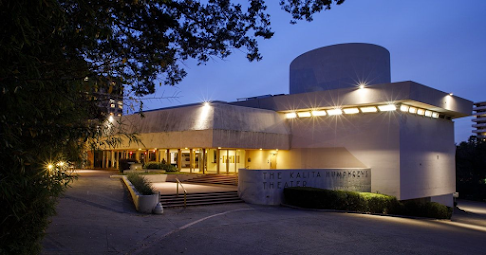Texas is not known for having many buildings designed by the famous American architect Frank Lloyd Wright (1867-1959); however, The Kalita Humphreys Theatre in Dallas can boast of having that distinction. Home to the award-winning Dallas Theatre Centre since it opened in 1959, "The Kalita Humphreys" as it is fondly called, is considered a local treasure well-deserving of the historic landmark designation it received in 2007 from the City of Dallas. It is named for an actress who had died in a plane crash in 1954 who had worked with the founding and first Director of the Dallas Theatre Center, Paul Baker. Following her death, her parents had donated $120,000. to the Theatre as a memorial.
 |
| Exterior and Entry circa 1960 Image: Messina Studios |
The architecture of The Kalita Humphreys Theatre was considered both innovative and bold at the time it was constructed back in the mid-1950s, although the original design had been created by Wright back in 1915 for a West Coast theatre and later adapted for a theatre in Hartford, Connecticut -- neither of which had ultimately been built.
Over the course of Wright's career, which spanned approximately 70 years, he created what has become to be known as "organic architecture", his signature design style in which unification of a building's form and function, the harmony of the building with its natural setting, and an aesthetically pleasing use of space all work together compatibly.
Because Wright's design for The Kalita Humphreys was based on nature, the interior spaces all at a 30/60-degree angle. The only 90-degree angles inside the theatre are where the walls meet the ceiling and floor, where not curved due to the cylindrical format of the building's overall exterior design. The cylindrical overall design which includes inter-connected "blocks" significantly lends itself as well to curved interior walls, auditorium design and seating, and multi-level interior spaces for various uses from public places, hallways and stairwells to classrooms, workrooms for making props and costumes, staff offices, dressing rooms and alternative performances areas.
The first stage production at the Theatre which premiered at its dedication on December 27, 1959, was Thomas Wolfe's "Of Time and The River", based on his 1935 novel. Almost immediately after its opening, the auditorium of The Kalita Humphreys became a powerful environmental space with a revolving stage that created an intimate relationship between the performers on stage and the audience seated in a theatre-in-the-round setting.
It also was the ideal site for the cutting- edge experimental theatre favoured by its founding director, Paul Baker.
In February of 2020, the Dallas Theatre Center announced plans to renovate the Kalita Humphreys, and selected architectural firm Diller Scofidio + Renfro to draft a new master plan for the nine-acre site. The firm has been tasked not only with re-imagining the Kalita Humphreys Theater and enhancing its access to the adjacent Katy Trail, it will also design two new theaters for the campus that will address spacial, programming, and educational needs.
In keeping with Frank Lloyd Wright’s organic, nature-inspired vision, the Master Plan will connect the Katy Trail, Dean Park and the surrounding neighborhoods of Uptown, Turtle Creek and Oak Lawn to the Kalita Humphreys Campus, making the entire site an accessible public space for all.
(Sources: dallastheatercenter.org; wrightinthepark.org; D Magazine article by Peter Simek published 02/25/2020)
© 2021 Snobby Tours®, Inc. All Rights Reserved.


